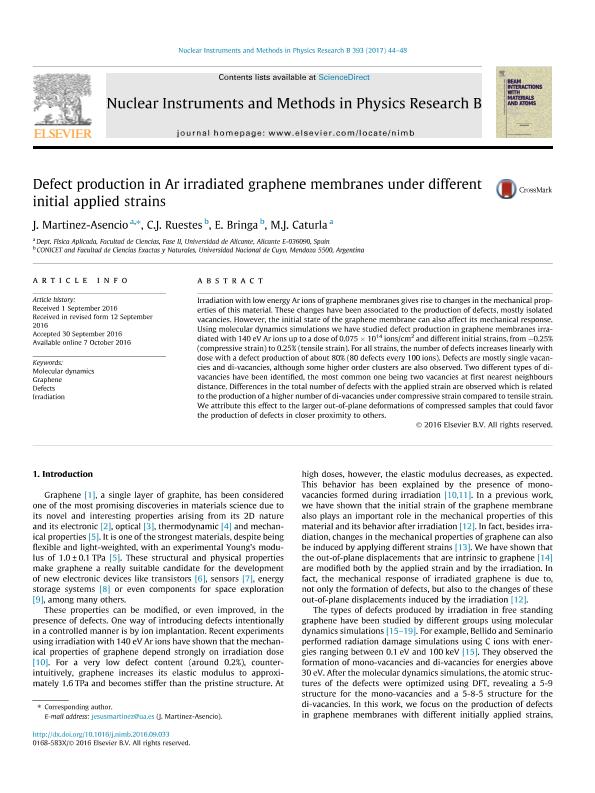Mostrar el registro sencillo del ítem
dc.contributor.author
Martinez Asencio, J.
dc.contributor.author
Ruestes, Carlos Javier

dc.contributor.author
Bringa, Eduardo Marcial

dc.contributor.author
Caturla, M. J.
dc.date.available
2018-09-14T18:00:04Z
dc.date.issued
2017-02
dc.identifier.citation
Martinez Asencio, J.; Ruestes, Carlos Javier; Bringa, Eduardo Marcial; Caturla, M. J.; Defect production in Ar irradiated graphene membranes under different initial applied strains; Elsevier Science; Beam Interactions with Materials and Atoms; 393; 2-2017; 44-48
dc.identifier.issn
0168-583X
dc.identifier.uri
http://hdl.handle.net/11336/59715
dc.description.abstract
Irradiation with low energy Ar ions of graphene membranes gives rise to changes in the mechanical properties of this material. These changes have been associated to the production of defects, mostly isolated vacancies. However, the initial state of the graphene membrane can also affect its mechanical response. Using molecular dynamics simulations we have studied defect production in graphene membranes irradiated with 140 eV Ar ions up to a dose of 0.075 × 1014 ions/cm2 and different initial strains, from −0.25% (compressive strain) to 0.25% (tensile strain). For all strains, the number of defects increases linearly with dose with a defect production of about 80% (80 defects every 100 ions). Defects are mostly single vacancies and di-vacancies, although some higher order clusters are also observed. Two different types of di-vacancies have been identified, the most common one being two vacancies at first nearest neighbours distance. Differences in the total number of defects with the applied strain are observed which is related to the production of a higher number of di-vacancies under compressive strain compared to tensile strain. We attribute this effect to the larger out-of-plane deformations of compressed samples that could favor the production of defects in closer proximity to others.
dc.format
application/pdf
dc.language.iso
eng
dc.publisher
Elsevier Science

dc.rights
info:eu-repo/semantics/openAccess
dc.rights.uri
https://creativecommons.org/licenses/by-nc-sa/2.5/ar/
dc.subject
Defects
dc.subject
Graphene
dc.subject
Irradiation
dc.subject
Molecular Dynamics
dc.subject.classification
Astronomía

dc.subject.classification
Ciencias Físicas

dc.subject.classification
CIENCIAS NATURALES Y EXACTAS

dc.title
Defect production in Ar irradiated graphene membranes under different initial applied strains
dc.type
info:eu-repo/semantics/article
dc.type
info:ar-repo/semantics/artículo
dc.type
info:eu-repo/semantics/publishedVersion
dc.date.updated
2018-09-12T17:31:15Z
dc.journal.volume
393
dc.journal.pagination
44-48
dc.journal.pais
Países Bajos

dc.journal.ciudad
Amsterdam
dc.description.fil
Fil: Martinez Asencio, J.. Universidad de Alicante; España
dc.description.fil
Fil: Ruestes, Carlos Javier. Consejo Nacional de Investigaciones Científicas y Técnicas; Argentina. Universidad Nacional de Cuyo. Facultad de Ciencias Exactas y Naturales; Argentina
dc.description.fil
Fil: Bringa, Eduardo Marcial. Consejo Nacional de Investigaciones Científicas y Técnicas; Argentina. Universidad Nacional de Cuyo. Facultad de Ciencias Exactas y Naturales; Argentina
dc.description.fil
Fil: Caturla, M. J.. Universidad de Alicante; España
dc.journal.title
Beam Interactions with Materials and Atoms

dc.relation.alternativeid
info:eu-repo/semantics/altIdentifier/doi/https://dx.doi.org/10.1016/j.nimb.2016.09.033
dc.relation.alternativeid
info:eu-repo/semantics/altIdentifier/url/https://www.sciencedirect.com/science/article/pii/S0168583X16304220
Archivos asociados
